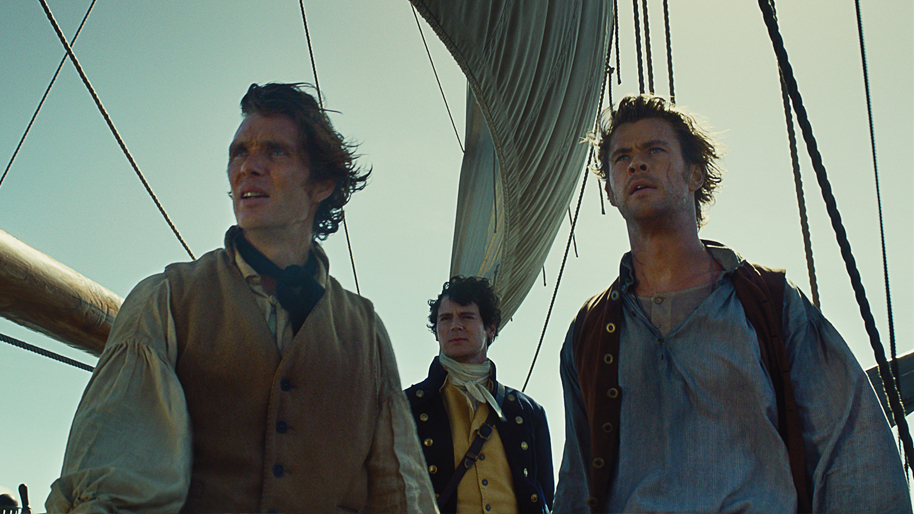 Title: In the Heart of the Sea | Rated: PG-13 | Duration: 121 min | Theaters wide (reducing)
Title: In the Heart of the Sea | Rated: PG-13 | Duration: 121 min | Theaters wide (reducing)
Survival stories are among the most fascinating that you’ll ever hear or read about, especially if they’re true. Survival is such a compelling subject matter due to the idea of humankind stripped of any easy way out, left to pit only knowledge and wit against Mother Nature’s ruthlessness. In the Heart of the Sea, adapted from Nathaniel Philbrick’s award-winning book of the same name, seeks to recount the incredible story of the whaleship Essex, but its punches don’t have the effects that it desires.
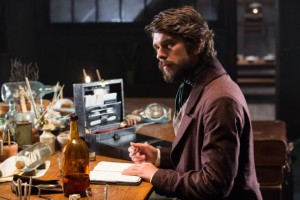 In 1850, Herman Melville (Ben Whishaw) travels to Nantucket Island, Massachusetts in search of innkeeper Thomas Nickerson (Brendan Gleeson), last survivor of the Essex‘s final voyage. Though initially reluctant to talk about his haunting ordeals, Nickerson is convinced to tell the author about the story of two other men aboard the ship: First Mate Owen Chase (Chris Hemsworth) and Captain George Pollard (Benjamin Walker). Despite clashing with each other, the two lead the Essex on a whaling expedition that culminates in a conflict against a vengeful sperm whale, which rams the ship and forces the crew to abandon it, leaving them thousands of miles away from help and with ever-dwindling supplies.
In 1850, Herman Melville (Ben Whishaw) travels to Nantucket Island, Massachusetts in search of innkeeper Thomas Nickerson (Brendan Gleeson), last survivor of the Essex‘s final voyage. Though initially reluctant to talk about his haunting ordeals, Nickerson is convinced to tell the author about the story of two other men aboard the ship: First Mate Owen Chase (Chris Hemsworth) and Captain George Pollard (Benjamin Walker). Despite clashing with each other, the two lead the Essex on a whaling expedition that culminates in a conflict against a vengeful sperm whale, which rams the ship and forces the crew to abandon it, leaving them thousands of miles away from help and with ever-dwindling supplies.
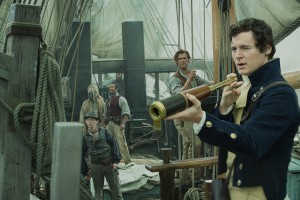 In the Heart of the Sea excels in its first half, as it pulls us into a whaler’s world. Director Ron Howard doesn’t just navigate through the Essex‘s every nook and cranny; he drops us right into the streets of 1820s Nantucket and lets its culture and lifestyle immerse us. In those sequences, he reveals small details that prove key in opening up this world, from the competition between whalers and the port’s wet streets to the demand for whale oil and how it affects the market. Details like these constantly come in over the course of this first half, and they make for an exhilarating first whaling sequence. Say what you want about the ethics or necessity of whaling, but you can’t deny that to see it unfold is fascinating, if not heartbreaking. The scenes following the whale’s death are even more engrossing, particularly when we see how the crew cut it apart and extract the oil itself. This is as much an olfactory film as it is a visual one, which is the result of an intimately-told first half.
In the Heart of the Sea excels in its first half, as it pulls us into a whaler’s world. Director Ron Howard doesn’t just navigate through the Essex‘s every nook and cranny; he drops us right into the streets of 1820s Nantucket and lets its culture and lifestyle immerse us. In those sequences, he reveals small details that prove key in opening up this world, from the competition between whalers and the port’s wet streets to the demand for whale oil and how it affects the market. Details like these constantly come in over the course of this first half, and they make for an exhilarating first whaling sequence. Say what you want about the ethics or necessity of whaling, but you can’t deny that to see it unfold is fascinating, if not heartbreaking. The scenes following the whale’s death are even more engrossing, particularly when we see how the crew cut it apart and extract the oil itself. This is as much an olfactory film as it is a visual one, which is the result of an intimately-told first half.
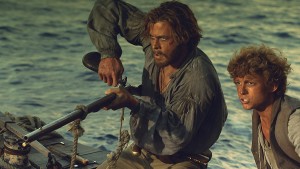 As great as the first half is, the second half should be the film’s strong point, but it unfortunately pales in comparison. The decision to frame the story of the Essex around Melville writing Nickerson’s account may not be fatal, but it does undercut the survival story’s compelling nature. While the film cuts back to the 1850 scenes at decent, sensible moments from a storytelling perspective, it doesn’t allow the crew’s survival story to truly take root and grow. This takes away from the account and the horrors of their predicament, and the emotional, cathartic beats are never struck with the “oomph” they need. As interesting as Melville writing what will become Moby Dick is, the film would be much stronger had it been solely about the ship’s final voyage and her crew’s gripping tale of survival. It doesn’t help that almost everyone on the Essex – save for the officers and young Nickerson (Tom Holland) – don’t breathe as characters, so it’s near-useless to remember names. There’s also the rogue whale, which the filmmakers use to inject action and tension even after the Essex sinking, but it comes across as a meek distraction and isn’t believable (I can’t comment on the film’s truthfulness since I haven’t read Philbrick’s book).
As great as the first half is, the second half should be the film’s strong point, but it unfortunately pales in comparison. The decision to frame the story of the Essex around Melville writing Nickerson’s account may not be fatal, but it does undercut the survival story’s compelling nature. While the film cuts back to the 1850 scenes at decent, sensible moments from a storytelling perspective, it doesn’t allow the crew’s survival story to truly take root and grow. This takes away from the account and the horrors of their predicament, and the emotional, cathartic beats are never struck with the “oomph” they need. As interesting as Melville writing what will become Moby Dick is, the film would be much stronger had it been solely about the ship’s final voyage and her crew’s gripping tale of survival. It doesn’t help that almost everyone on the Essex – save for the officers and young Nickerson (Tom Holland) – don’t breathe as characters, so it’s near-useless to remember names. There’s also the rogue whale, which the filmmakers use to inject action and tension even after the Essex sinking, but it comes across as a meek distraction and isn’t believable (I can’t comment on the film’s truthfulness since I haven’t read Philbrick’s book).
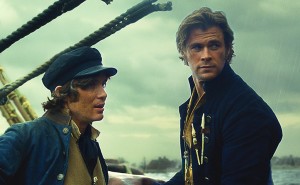 Howard has assembled a reliable cast, who are capable of working with what they have. Gleeson and Whishaw play off each other fairly well, and the former plays the part of a curmudgeonly, withdrawn Nickerson with panache. The film’s framing decision doesn’t quite do its 1820s cast any favors, as they are left with slim pickings instead of truly meaty material. Hemsworth is as charismatic as we know him, but Chase’s moments of grief and intensity are few and far between, which is surprising since he is the film’s leading character. Walker, who plays Pollard’s haughty, stiff personality with confidence, fares a bit better. Of all of the actors playing the Essex crew, Cillian Murphy – taking on the role of Second Mate Matthew Joy – comes closest to making an impression, as he nails his character’s swashbuckling nature and is committed to a physically expressive performance.
Howard has assembled a reliable cast, who are capable of working with what they have. Gleeson and Whishaw play off each other fairly well, and the former plays the part of a curmudgeonly, withdrawn Nickerson with panache. The film’s framing decision doesn’t quite do its 1820s cast any favors, as they are left with slim pickings instead of truly meaty material. Hemsworth is as charismatic as we know him, but Chase’s moments of grief and intensity are few and far between, which is surprising since he is the film’s leading character. Walker, who plays Pollard’s haughty, stiff personality with confidence, fares a bit better. Of all of the actors playing the Essex crew, Cillian Murphy – taking on the role of Second Mate Matthew Joy – comes closest to making an impression, as he nails his character’s swashbuckling nature and is committed to a physically expressive performance.
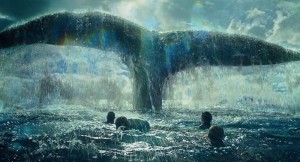 Recreating this tale to the best of their abilities is a talented technical crew. The film is a showcase for dynamic cinematographer Anthony Dod Mantle, who places his camera in creative places and goes tight on the actors’ faces to catch their emotions. He, along with production designer Mark Tildesley, create incredibly evocative images of the sea such that the finest Romanticist paintings of J.M.W. Turner come to mind. The makeup department is also on point here, with their work on full display as the characters become progressively sunburned and emaciated over the course of their harrowing journey. While the whales are mostly CGI, the picture is intentionally dark – almost murky – enough to have them mesh well with what is practical.
Recreating this tale to the best of their abilities is a talented technical crew. The film is a showcase for dynamic cinematographer Anthony Dod Mantle, who places his camera in creative places and goes tight on the actors’ faces to catch their emotions. He, along with production designer Mark Tildesley, create incredibly evocative images of the sea such that the finest Romanticist paintings of J.M.W. Turner come to mind. The makeup department is also on point here, with their work on full display as the characters become progressively sunburned and emaciated over the course of their harrowing journey. While the whales are mostly CGI, the picture is intentionally dark – almost murky – enough to have them mesh well with what is practical.
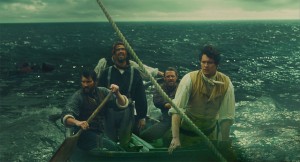 The tragedy of the Essex is a compelling story of survival, but In the Heart of the Sea doesn’t quite capture that compelling nature. A terrific first half pulls us into a whaler’s world before being followed by a second half undermined by some questionable storytelling decisions. The elements are certainly here to do justice to this story, but the film only skims the surface of this tale instead of diving headfirst into it.
The tragedy of the Essex is a compelling story of survival, but In the Heart of the Sea doesn’t quite capture that compelling nature. A terrific first half pulls us into a whaler’s world before being followed by a second half undermined by some questionable storytelling decisions. The elements are certainly here to do justice to this story, but the film only skims the surface of this tale instead of diving headfirst into it.
Rating: 3.0/5.0
* Photos courtesy of Warner Bros. Pictures
